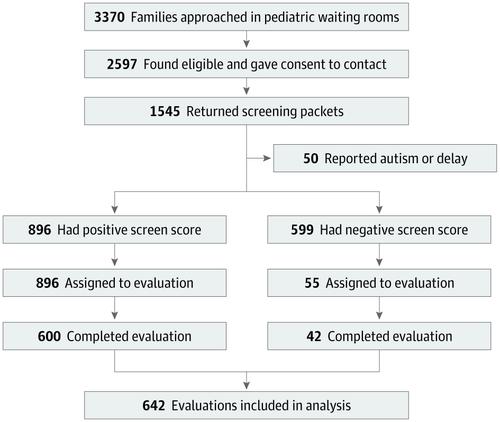当前位置:
X-MOL 学术
›
JAMA Pediatr.
›
论文详情
Our official English website, www.x-mol.net, welcomes your feedback! (Note: you will need to create a separate account there.)
Comparative Accuracy of Developmental Screening Questionnaires
JAMA Pediatrics ( IF 26.1 ) Pub Date : 2020-04-01 , DOI: 10.1001/jamapediatrics.2019.6000 R Christopher Sheldrick 1 , Susan Marakovitz 2 , Daryl Garfinkel 2 , Alice S Carter 3 , Ellen C Perrin 2
JAMA Pediatrics ( IF 26.1 ) Pub Date : 2020-04-01 , DOI: 10.1001/jamapediatrics.2019.6000 R Christopher Sheldrick 1 , Susan Marakovitz 2 , Daryl Garfinkel 2 , Alice S Carter 3 , Ellen C Perrin 2
Affiliation

|
Importance
Universal developmental screening is widely recommended, yet studies of the accuracy of commonly used questionnaires reveal mixed results, and previous comparisons of these questionnaires are hampered by important methodological differences across studies. Objective
To compare the accuracy of 3 developmental screening instruments as standardized tests of developmental status. Design, Setting, and Participants
This cross-sectional diagnostic accuracy study recruited consecutive parents in waiting rooms at 10 pediatric primary care offices in eastern Massachusetts between October 1, 2013, and January 31, 2017. Parents were included if they were sufficiently literate in the English or Spanish language to complete a packet of screening questionnaires and if their child was of eligible age. Parents completed all questionnaires in counterbalanced order. Participants who screened positive on any questionnaire plus 10% of those who screened negative on all questionnaires (chosen at random) were invited to complete developmental testing. Analyses were weighted for sampling and nonresponse and were conducted from October 1, 2013, to January 31, 2017. Exposures
The 3 screening instruments used were the Ages & Stages Questionnaire, Third Edition (ASQ-3); Parents' Evaluation of Developmental Status (PEDS); and Survey of Well-being of Young Children (SWYC): Milestones. Main Outcomes and Measures
Reference tests administered were Bayley Scales of Infant and Toddler Development, Third Edition, for children aged 0 to 42 months, and Differential Ability Scales, Second Edition, for older children. Age-standardized scores were used as indicators of mild (80-89), moderate (70-79), or severe (<70) delays. Results
A total of 1495 families of children aged 9 months to 5.5 years participated. The mean (SD) age of the children at enrollment was 2.6 (1.3) years, and 779 (52.1%) were male. Parent respondents were primarily female (1325 [88.7%]), with a mean (SD) age of 33.4 (6.3) years. Of the 20.5% to 29.0% of children with a positive score on each questionnaire, 35% to 60% also received a positive score on a second questionnaire, demonstrating moderate co-occurrence. Among younger children (<42 months), the specificity of the ASQ-3 (89.4%; 95% CI, 85.9%-92.1%) and SWYC Milestones (89.0%; 95% CI, 86.1%-91.4%) was higher than that of the PEDS (79.6%; 95% CI, 75.7%-83.1%; P < .001 and P = .002, respectively), but differences in sensitivity were not statistically significant. Among older children (43-66 months), specificity of the ASQ-3 (92.1%; 95% CI, 85.1%-95.9%) was higher than that of the SWYC Milestones (70.7%; 95% CI, 60.9%-78.8%) and the PEDS (73.7%; 95% CI, 64.3%-81.3%; P < .001), but sensitivity to mild delays of the SWYC Milestones (54.8%; 95% CI, 38.1%-70.4%) and of the PEDS (61.8%; 95% CI, 43.1%-77.5%) was higher than that of the ASQ-3 (23.5%; 95% CI, 9.0%-48.8%; P = .012 and P = .002, respectively). Sensitivity exceeded 70% only with respect to severe delays, with 73.7% (95% CI, 50.1%-88.6%) for the SWYC Milestones among younger children, 78.9% (95% CI, 55.4%-91.9%) for the PEDS among younger children, and 77.8% (95% CI, 41.8%-94.5%) for the PEDS among older children. Attending to parents' concerns was associated with increased sensitivity of all questionnaires. Conclusions and Relevance
This study found that 3 frequently used screening questionnaires offer adequate specificity but modest sensitivity for detecting developmental delays among children aged 9 months to 5 years. The results suggest that trade-offs in sensitivity and specificity occurred among the questionnaires, with no one questionnaire emerging superior overall.
中文翻译:

发育筛查问卷的比较准确度
重要性 普遍推荐普遍发育筛查,但对常用问卷准确性的研究显示结果喜忧参半,而且之前对这些问卷的比较受到研究之间重要的方法学差异的阻碍。目的比较3种发育筛查工具作为发育状态标准化测试的准确性。设计、设置和参与者 这项横断面诊断准确性研究于 2013 年 10 月 1 日至 2017 年 1 月 31 日期间在马萨诸塞州东部 10 个儿科初级保健办公室的候诊室招募了连续父母。用英语或西班牙语完成一包筛查问卷,如果他们的孩子达到合格年龄。家长按平衡顺序完成所有问卷。在任何问卷中筛选出阳性的参与者加上所有问卷中筛选出阴性的参与者(随机选择)的 10% 被邀请完成发育测试。2013 年 10 月 1 日至 2017 年 1 月 31 日对抽样和无应答进行加权分析。 暴露 使用的 3 种筛查工具是年龄和阶段问卷,第三版 (ASQ-3);父母的发育状况评估(PEDS);和幼儿幸福感调查 (SWYC):里程碑。主要结果和措施 实施的参考测试是贝利婴幼儿发展量表,第三版,适用于 0 至 42 个月的儿童,以及差异能力量表,第二版,适用于年龄较大的儿童。年龄标准化分数被用作轻度 (80-89)、中度 (70-79) 或重度 (<70) 延迟的指标。结果 共有 1495 个 9 个月至 5.5 岁儿童家庭参与。入学儿童的平均 (SD) 年龄为 2.6 (1.3) 岁,其中 779 (52.1%) 名是男性。家长受访者主要是女性 (1325 [88.7%]),平均 (SD) 年龄为 33.4 (6.3) 岁。20.5% 至 29.0% 的儿童在每份问卷上都获得了积极的分数,35% 至 60% 的儿童在第二份问卷中也获得了积极的分数,表明中等程度的共现。在年幼儿童(<42 个月)中,ASQ-3(89.4%;95% CI,85.9%-92.1%)和 SWYC 里程碑(89.0%;95% CI,86.1%-91.4%)的特异性高于PEDS (79.6%; 95% CI, 75.7%-83.1%; P < .001 and P = .002,分别), 但敏感性差异无统计学意义。在年龄较大的儿童(43-66 个月)中,ASQ-3(92.1%;95% CI,85.1%-95.9%)的特异性高于 SWYC 里程碑(70.7%;95% CI,60.9%-78.8) %) 和 PEDS (73.7%; 95% CI, 64.3%-81.3%; P < .001),但对 SWYC Milestones (54.8%; 95% CI, 38.1%-70.4%) 和PEDS (61.8%; 95% CI, 43.1%-77.5%) 高于 ASQ-3 (23.5%; 95% CI, 9.0%-48.8%; P = .012 and P = .002,分别)。仅在严重延误方面的敏感性超过 70%,对于年幼儿童的 SWYC Milestones 为 73.7%(95% CI,50.1%-88.6%),对于 PEDS 为 78.9%(95% CI,55.4%-91.9%)年龄较小的儿童,77.8% (95% CI, 41.8%-94.5%) 对于年龄较大的儿童的 PEDS。参加家长会 担忧与所有问卷的敏感性增加有关。结论和相关性 本研究发现,3 种常用筛查问卷为检测 9 个月至 5 岁儿童的发育迟缓提供了足够的特异性,但敏感性适中。结果表明,问卷之间在敏感性和特异性方面进行了权衡,没有一份问卷总体上表现优异。
更新日期:2020-04-01
中文翻译:

发育筛查问卷的比较准确度
重要性 普遍推荐普遍发育筛查,但对常用问卷准确性的研究显示结果喜忧参半,而且之前对这些问卷的比较受到研究之间重要的方法学差异的阻碍。目的比较3种发育筛查工具作为发育状态标准化测试的准确性。设计、设置和参与者 这项横断面诊断准确性研究于 2013 年 10 月 1 日至 2017 年 1 月 31 日期间在马萨诸塞州东部 10 个儿科初级保健办公室的候诊室招募了连续父母。用英语或西班牙语完成一包筛查问卷,如果他们的孩子达到合格年龄。家长按平衡顺序完成所有问卷。在任何问卷中筛选出阳性的参与者加上所有问卷中筛选出阴性的参与者(随机选择)的 10% 被邀请完成发育测试。2013 年 10 月 1 日至 2017 年 1 月 31 日对抽样和无应答进行加权分析。 暴露 使用的 3 种筛查工具是年龄和阶段问卷,第三版 (ASQ-3);父母的发育状况评估(PEDS);和幼儿幸福感调查 (SWYC):里程碑。主要结果和措施 实施的参考测试是贝利婴幼儿发展量表,第三版,适用于 0 至 42 个月的儿童,以及差异能力量表,第二版,适用于年龄较大的儿童。年龄标准化分数被用作轻度 (80-89)、中度 (70-79) 或重度 (<70) 延迟的指标。结果 共有 1495 个 9 个月至 5.5 岁儿童家庭参与。入学儿童的平均 (SD) 年龄为 2.6 (1.3) 岁,其中 779 (52.1%) 名是男性。家长受访者主要是女性 (1325 [88.7%]),平均 (SD) 年龄为 33.4 (6.3) 岁。20.5% 至 29.0% 的儿童在每份问卷上都获得了积极的分数,35% 至 60% 的儿童在第二份问卷中也获得了积极的分数,表明中等程度的共现。在年幼儿童(<42 个月)中,ASQ-3(89.4%;95% CI,85.9%-92.1%)和 SWYC 里程碑(89.0%;95% CI,86.1%-91.4%)的特异性高于PEDS (79.6%; 95% CI, 75.7%-83.1%; P < .001 and P = .002,分别), 但敏感性差异无统计学意义。在年龄较大的儿童(43-66 个月)中,ASQ-3(92.1%;95% CI,85.1%-95.9%)的特异性高于 SWYC 里程碑(70.7%;95% CI,60.9%-78.8) %) 和 PEDS (73.7%; 95% CI, 64.3%-81.3%; P < .001),但对 SWYC Milestones (54.8%; 95% CI, 38.1%-70.4%) 和PEDS (61.8%; 95% CI, 43.1%-77.5%) 高于 ASQ-3 (23.5%; 95% CI, 9.0%-48.8%; P = .012 and P = .002,分别)。仅在严重延误方面的敏感性超过 70%,对于年幼儿童的 SWYC Milestones 为 73.7%(95% CI,50.1%-88.6%),对于 PEDS 为 78.9%(95% CI,55.4%-91.9%)年龄较小的儿童,77.8% (95% CI, 41.8%-94.5%) 对于年龄较大的儿童的 PEDS。参加家长会 担忧与所有问卷的敏感性增加有关。结论和相关性 本研究发现,3 种常用筛查问卷为检测 9 个月至 5 岁儿童的发育迟缓提供了足够的特异性,但敏感性适中。结果表明,问卷之间在敏感性和特异性方面进行了权衡,没有一份问卷总体上表现优异。

























 京公网安备 11010802027423号
京公网安备 11010802027423号